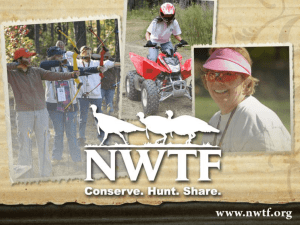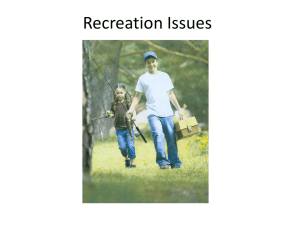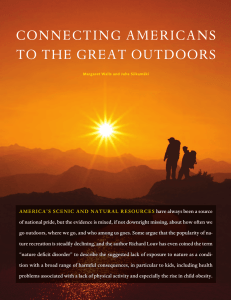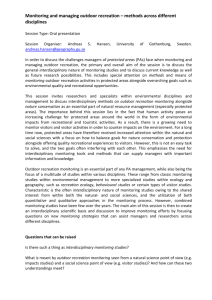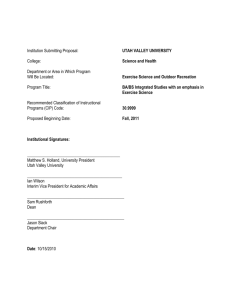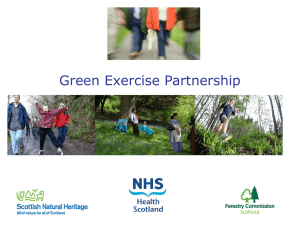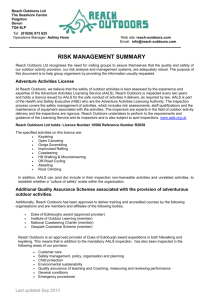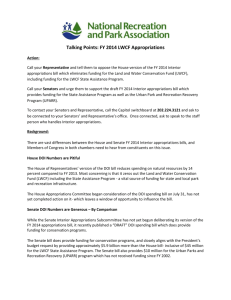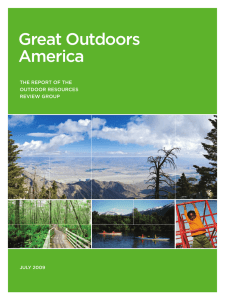Document - Council for Watershed Health
advertisement
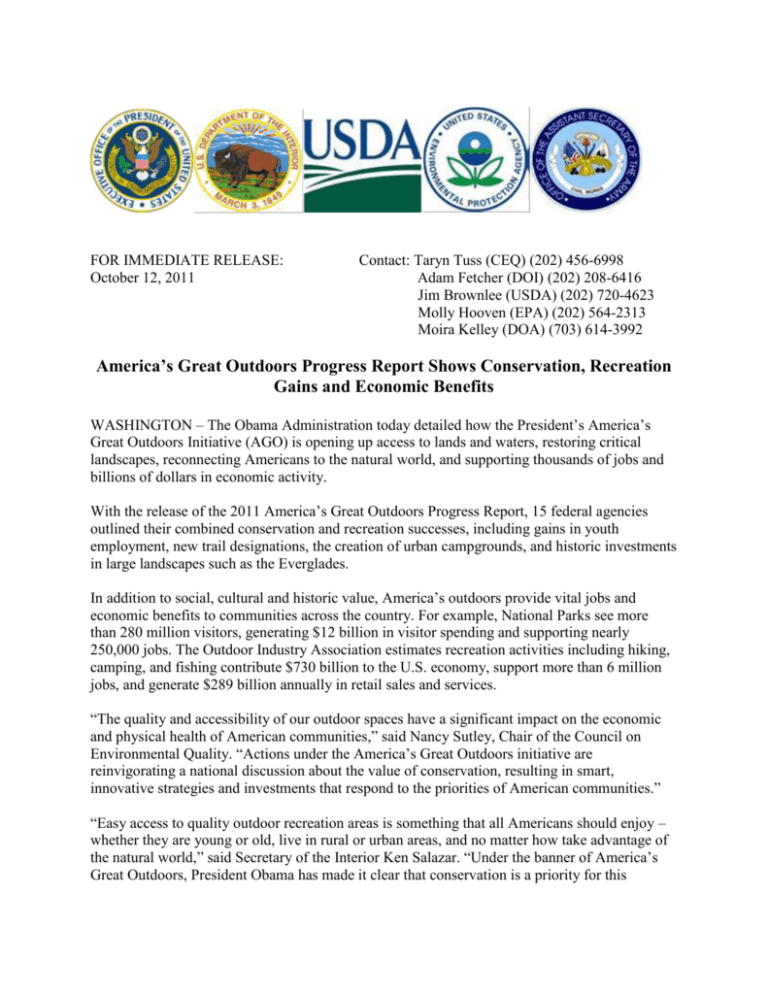
FOR IMMEDIATE RELEASE: October 12, 2011 Contact: Taryn Tuss (CEQ) (202) 456-6998 Adam Fetcher (DOI) (202) 208-6416 Jim Brownlee (USDA) (202) 720-4623 Molly Hooven (EPA) (202) 564-2313 Moira Kelley (DOA) (703) 614-3992 America’s Great Outdoors Progress Report Shows Conservation, Recreation Gains and Economic Benefits WASHINGTON – The Obama Administration today detailed how the President’s America’s Great Outdoors Initiative (AGO) is opening up access to lands and waters, restoring critical landscapes, reconnecting Americans to the natural world, and supporting thousands of jobs and billions of dollars in economic activity. With the release of the 2011 America’s Great Outdoors Progress Report, 15 federal agencies outlined their combined conservation and recreation successes, including gains in youth employment, new trail designations, the creation of urban campgrounds, and historic investments in large landscapes such as the Everglades. In addition to social, cultural and historic value, America’s outdoors provide vital jobs and economic benefits to communities across the country. For example, National Parks see more than 280 million visitors, generating $12 billion in visitor spending and supporting nearly 250,000 jobs. The Outdoor Industry Association estimates recreation activities including hiking, camping, and fishing contribute $730 billion to the U.S. economy, support more than 6 million jobs, and generate $289 billion annually in retail sales and services. “The quality and accessibility of our outdoor spaces have a significant impact on the economic and physical health of American communities,” said Nancy Sutley, Chair of the Council on Environmental Quality. “Actions under the America’s Great Outdoors initiative are reinvigorating a national discussion about the value of conservation, resulting in smart, innovative strategies and investments that respond to the priorities of American communities.” “Easy access to quality outdoor recreation areas is something that all Americans should enjoy – whether they are young or old, live in rural or urban areas, and no matter how take advantage of the natural world,” said Secretary of the Interior Ken Salazar. “Under the banner of America’s Great Outdoors, President Obama has made it clear that conservation is a priority for this administration. We will continue to invest in land and water projects that have the backing of communities who depend on the job-creating power of the outdoor economy.” “AGO is not only protecting our environment, it's creating jobs,” said Secretary of Agriculture Tom Vilsack. “We're working with farmers and ranchers to conserve working agricultural lands; we're restoring our forests in ways that create jobs in recreation and forest products; and we're creating employment opportunities for young adults, veterans and others on our National Forests.” "Through this initiative, we're reconnecting Americans with the great outdoors and helping to put local residents to work cleaning up the areas that they cherish," EPA Administrator Lisa P. Jackson said. "In preserving their environment, Americans are creating healthier, more vibrant communities today and ensuring lasting prosperity for future generations." “America's Great Outdoors initiative focuses on reconnecting Americans to their natural environments,” said Jo-Ellen Darcy, Assistant Secretary of the Army (Civil Works). “This is beneficial for many reasons; health, community, ecosystem restoration and most importantly the happiness and well-being of our children. Not all cities, towns and rural areas in this country are blessed with easy accessibility to outdoor recreation. This initiative is about engaging communities with the outdoors; kids in particular.” President Obama launched AGO in April 2010 to foster a 21st century approach to conservation that is designed by and accomplished in partnership with the American people. In February, the Council on Environmental Quality, U.S. Department of Interior (DOI), U.S. Department of Agriculture (USDA) and U.S. Environmental Protection Agency (EPA) presented an AGO report to the President outlining a conservation action plan using input received from more than 100,000 public comments and 51 public listening sessions across the country. The Progress Report released today describes how agencies are working together and with private sector, non-profit and community partners to leverage resources and deliver on-theground results for Americans. For example: USDA announced $100 million in landowner agreements with farmers and ranchers to restore wetlands and permanently conserve nearly 24,000 acres of agricultural land in the Northern Everglades. EPA awarded nearly $30 million in Great Lakes Restoration Initiative grants, including funds to groom Chicago’s to 24 beaches on a daily basis and build a protective barrier to make swimming areas cleaner. These actions should result in fewer swimming bans and advisories due to contamination. DOI worked with the U.S. Army Corps of Engineers to designate 41 National Recreation Trails stretching across 17 states, adding 650 miles to the national trails system. USDA improved access for hunting by enrolling eight additional states and one tribe in the “Open Fields” Voluntary Public Access Program, which works with states to provide landowners with incentives to expand lands available for hunting. Federal agencies and partners worked together to provide more than 50,000 young people with paid work and service learning opportunities on public lands and waters over the past two years. DOI and USACE worked together to designate three new National Water Trails including the Lake Michigan National Water Trail in Illinois and Indiana, the Quinebaug River Water Trail in Connecticut, and the Susquehanna River Water Trail in Pennsylvania. Led by EPA, USDA, DOI and the Department of Housing and Urban Developmen, 11 agencies came together to form the Federal Urban Waters Partnership, leveraging Federal funds to revitalize urban waters and surrounding communities through pilot projects in seven initial cities. USDA worked with other Federal agencies to launch new landscape-scale projects in Saginaw Bay, Michigan; Monterey Bay, California; and the Lake Champlain area in New York and Vermont, investing $3.5 million to underwrite conservation activities on working lands based on extensive stakeholder input. In the year ahead, agencies will collaborate on new initiatives including: Landscape-scale conservation in the longleaf pine ecosystem, the grasslands of the northern Great Plains, the Crown of the Continent in the northern Rockies, the southwest deserts, and the northern forests of New England and New York. Pilot projects that bring together agency resources to increase access to urban parks and waterways. Public-private partnerships that will deliver on-the-ground conservation and restoration outcomes across America’s military installations, national forests, national wildlife refuges, state lands, and working private lands. Additionally, the Department of the Interior will soon release a 50-state report outlining 100 locally-supported outdoor initiatives that promise to reconnect Americans to the natural world as part of AGO. The projects identified in the forthcoming report will represent what states believe are among the best investments in the nation to support a healthy, active population, and create travel, tourism and outdoor recreation jobs across the country. The report is a result of 50 meetings with Governors and stakeholders held by Secretary Salazar and other senior Interior officials to solicit ideas on how to best implement AGO in their states. To read the Progress Report or for more information about the America’s Great Outdoors initiative, visit: www.americasgreatoutdoors.gov or www.whitehouse.gov/administration/eop/ceq/initiatives/ago.
